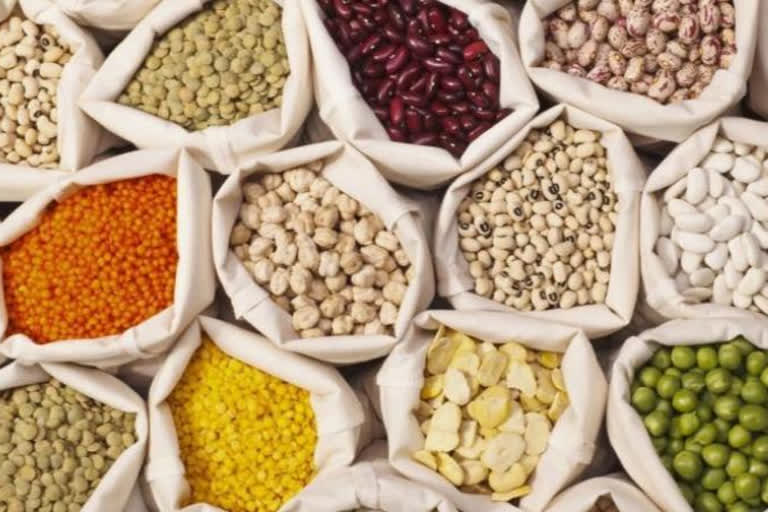Hyderabad: The necessity of pulses in the food needs of the countrymen is steadily growing. Two decades ago 1.4 crore tonnes of pulses were produced in about 2.2 crore hectares of land in the country. This was sufficient to meet the demand of the day.
But by 2010, things have changed. Countrywide demand for pulses has doubled. In a total of 2.6 crore hectares, about 1.6 crore tonnes of pulses were harvested; yet, the yield was not enough because of increased demand.
Domestic demand for pulses has steadily risen to 2.2 crore tonnes by 2015. As a result, imports have increased to 50 lakh tonnes. It is worth noting that in 2015, the price of Toor Dal reached to Rs 180 a kg in the market. In those circumstances, 56 lakh tonnes of pulses were imported.
The following year the same situation continued, with the result 63 lakh tonnes were imported. Due to heavy imports, prices were stabilized domestically. But gradually the prices of pulses in the market have plummeted resulting in heavy losses to farmers.
As a result, the Indian Food Corporation intervened and bought a large number of pulses from the farmers. At the end of the year, 20 lakh tonnes of the stock remained with it. The farmers and the government had to suffer financially.
Due to low prices, the general consumer had some relief. Because of these developments, the country's crop area of pulses has been raised to three crore hectares. Imports of pulses from overseas this year may be well below ten lakh tonnes. Prices have remained stable to an extent. How long this situation will continue is uncertain.
Focus on Imports
Pulses are mainly rain-fed crops. In a way, it is a challenge to ensure more yields and also satisfy the farmers with good support price. Efforts to develop new pulse varieties to increase yields in the country have been going on for some time. The Pulses Research Institute in Kanpur is conducting several kinds of research on this. By 2030, the country's population may cross 150 crores. The demand for pulses would rise to 3.3 crore tonnes by then.
On average, the present yield of pulses for hectare is 835 kgs. Keeping in view the future demand, an increase of 30 percent yield per hectare is necessary.
Despite the best efforts, the average yield of pulses has not increased beyond 20 percent in the last decade. While ensuring imports, it is necessary to provide proper support price to the farmer for his produce.
At the same time, it is also important to see that the prices of pulses are within the reach of the general public. Since pulses are mainly rain-fed crops, selection of short-term yielding varieties will be beneficial. More in-depth research in this direction is very essential.
On the other hand, pests are heavily damaging the crops. Pests like gram pod borer, pod fly, etc. are heavily damaging Toor Dal crop and also Cotton crop. The farming community is using pesticides indiscriminately to control the pests. However, these worms are successfully damaging up to 50% of the crops.
Strong varieties could be created to some extent by research but the more mature effort is required in this direction. Over ten percent of yields are being lost due to water shortage. By following drip irrigation and micro-irrigation methods, water can be conserved substantially and losses can be avoided.
The government has to invest heavily in this. Pulses are one of the crops that consume the least water. The roots of these crops go deeper into the ground. So they yield produce with less water. Their roots are capable of increasing nitrogen in the ground. These crops are very useful for climate protection. For this reason, they should be cultivated in a big way.
Brokers make more profits
There is a wide gap between the prices paid to farmers and the prices paid by the general public to buy the product in the market. Brokers create this gap between the selling and buying prices and make good profits. We need to find ways to connect farmers with the direct market to curb the middlemen monopoly. Digital Internet markets are very useful for this.
The government intends to create production societies with farmer groups and assign them powers to overcome difficulties related to pricing. The government is planning to create ten thousand production societies in the country. Farmers should respond positively to this. These production societies will refine the pulses at the village level and 'pack' them appropriately and supply to online markets such as Amazon and Big Basket and also to supermarkets and shops in cities.
This ensures the farmer a fair price and pulses are also available to consumers at a reduced price. These should be made an integral part of the distribution through ration shops. Pulses must be essentially included in the mid-day meal scheme in schools.
Thereby, nutrition will be ensured for future generations. Increasing the yield of legumes with reasonable incentives will greatly benefit the economic and social health of the nation.
Research needs to be sharpened
The National Food Security Mission has undertaken several projects to increase the production of pulses. Rs 296 crore has been earmarked to increase crop area in 15 states across the country.
A project has been launched to encourage the cultivation of pulses in sugarcane fields as a mixed crop. A special program has been initiated to increase the harvest of green gram and black gram in additional 12 lakh hectares of paddy fields after the main (sarva) paddy harvest.
The main reason for the lack of expected yields of pulses in the country is the non-availability of strong and quality varieties that can withstand pests and give good yields. There is a need for extensive research on insect tolerance and better yielding varieties.



